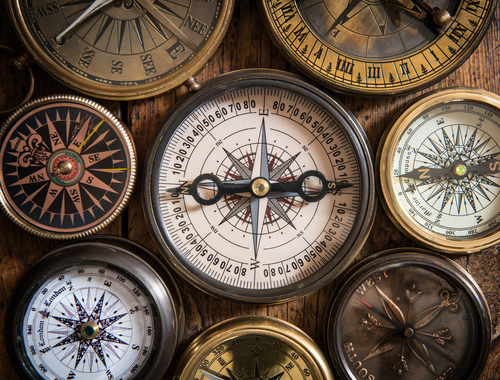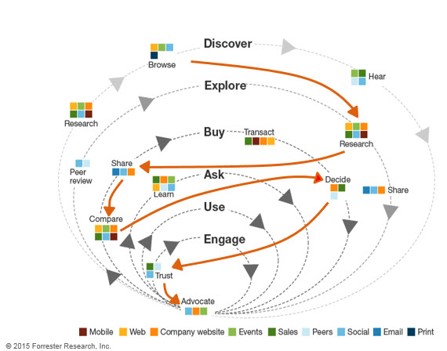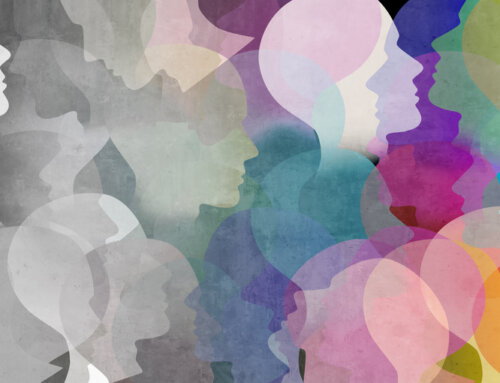Put simply, the buyer’s journey is the active process buyers go through to become aware of, consider, evaluate and the decision making that leads to a purchase of a new product or service. The process of zero (no awareness of your product or service) to sale (a purchase).
Conceptually the journey consists of a three-step process, but there’s a lot more to it than that…We’ll take a look at each of the steps and how to engage your prospective buyers at each stage.
As a business it’s important to understand not just how people research and purchase, but also the challenges, problems and pain points that form the beginning of their journey. What is the trigger that starts them off on their journey? You also need to consider how they move along the different stages of their journey.
The buyer’s journey stages
The graphic below shows a simplified illustration of the three generic steps of a buyer’s journey. There are a number of alternative versions of this model, which include additional steps, but essentially, they all illustrate the same general steps.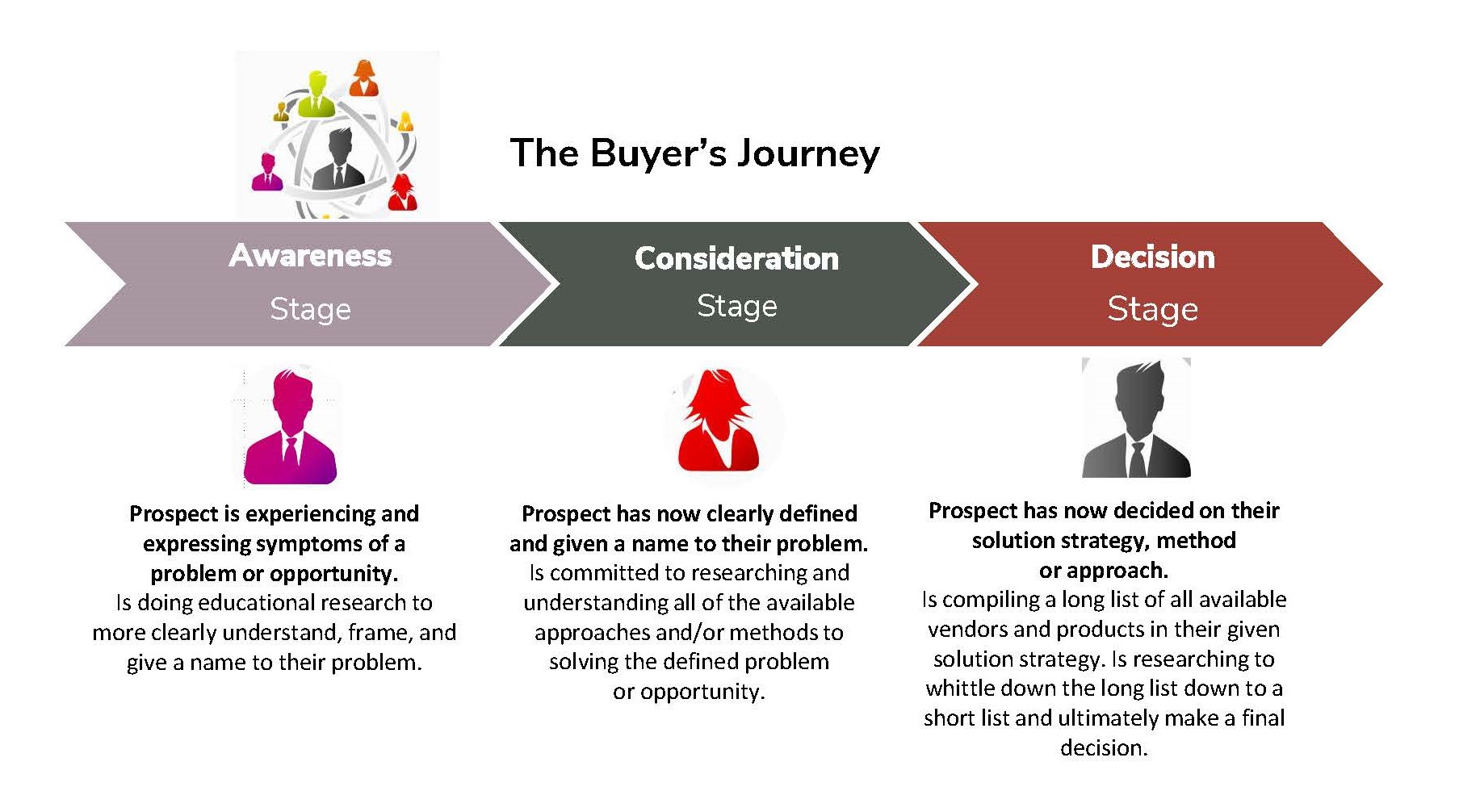
1. Awareness
The buyer realises that they have a problem. They recognise they have a problem or a challenge and their research at this stage is to understand their problem better in order to define it, rather than looking for a solution to it. Its useful to recognise that they may not realise it’s a problem and research will trigger idea’s on area’s of improvement.
2. Consideration
The buyer has better clarity around their problem and researches ways to solve it. They have defined their problem and they are now trying to understand the different potential solutions available to them.
3. Decision
The buyer chooses a solution. The buyer knows how to solve their problem and researches the products or services to do just that. At this stage they will compare providers and whittle down a list, ultimately making a purchase decision.
Why is it important to understand the buyer’s journey?
As much as we would like it to be, the buyer’s journey is not linear as the previous graphic suggests. Customers do not move through sequential steps from zero to purchase.
In today’s digital world, the buyer journey is considerably more ‘self-drive’ and multi-dimensional. Buyer’s spend time looping around at different stages of the journey, as the illustration below from Forrester demonstrates. With the quantity and quality of easily available information through digital channels, buyers control their own journey. That means sellers have less access and opportunities interact and to influence customer decisions.
Potential customers are seeking out information, so providing informative, valuable content to enable them to understand their problem and the potential approaches to solving it is key.
Defining your company’s buyer’s journey
Defining your company’s buyer’s journey will help you sell but let’s face it, this can be tough. Today most people start with a google search, but many of us probably can’t remember all the steps we took before making a final decision to purchase.
Building a clear understanding may take time and be an iterative process. If you don’t feel you have a good understanding of your buyers, and the steps they took to find you and ultimately buy from you, then conduct a few interviews with customers and talk to prospects. Perhaps start asking the question ‘how did you hear about us’ early on in the sales conversation with a prospect. Talk to other staff that interact with prospects and customers.
Compelling stats that justify the importance of understanding your buyer’s journey
Check out the following analysis and insights on behaviours within the B2B buyer’s journey. They really demonstrate the importance of understanding your buyer’s journey.
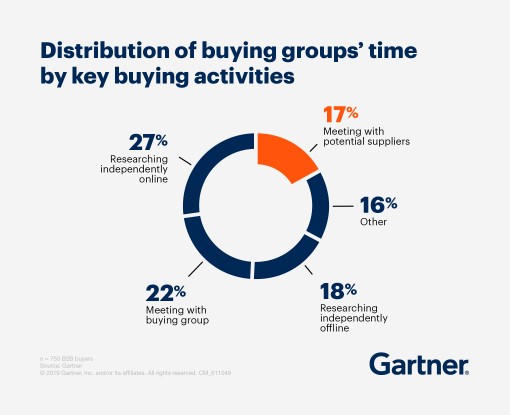
(Source: Gartner)
- When B2B buyers are considering a purchase, the majority (27%) of that time is spent researching independently online. Just 17% is spent meeting with potential suppliers. (Source: Gartner)
- 77% of B2B buyers said the last purchase they made was complex or difficult. (Source: Gartner)
- Four in 10 B2B companies worldwide said they believe capturing a complete view of the customer is a big priority in the next two years. (Source: eMarketer)
- 71%of B2B researchers start with a generic search, rather than looking for a particular brand
- 80% of the buying process will occur without direct human interaction by 2020 (source: forrester.com))
- More than half (57%) of B2B purchase decisions are made before submitting the request. (Source: Zfort Group)
- At least 80% of B2B buyers are not only looking for but expect a buying experience like that of a B2C customer. (source: Lumoa, 2019)
- Most B2B buyers perform 12 online searches before interacting with a vendor/supplier and are looking for a B2C-like experience. (source: Blue Corona, 2019)
- 77% of B2B buyers are conducting more detailed ROI analysis before making a purchase decision, 75% are using more information sources for research and evaluation, and 52% are increasing the number of buying group members. (source: Demand Gen Report, 2019)
- More than half of all B2B buyers view at least eight pieces of content during the purchase process, and 82% of buyers viewed at least five pieces of content from the vendor prior to purchase. (source: Forrester)
- 49% of B2B buyers said they rely more on content to carry out their research and make buying decisions (source: Smart Insights)
- 81% of businesses have reported their blog as useful or critical to generating leads.(source: Nurture)
Buyer’s journey content
Ideally you need to create a variety of content that helps your target audience at each stage of their buyer’s journey. If you get this right you have a better chance of engaging with them through various channels and getting them to engage with your website.
Your ideal customer wants the right content at the right time, which is whenever they need it, and they want it in the format they prefer. This means creating content in a format that your buyer’s want. Always think about the buyer’s journey through their lens… not yours.
By creating content aligned with the buyer’s journey you should always be able to provide them with helpful, relevant content that will be genuinely useful and will aid them in moving along their buyer’s journey.
Download your free copy of The Buyer’s Journey template.
If you’re struggling with understanding how to map out your buyer’s journey to win your dream customers, get in touch hello@intelligentmarketing.uk.com.
